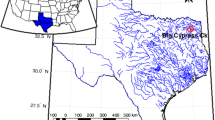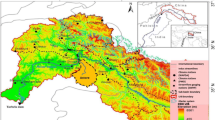Abstract
Over the past years, some artificial intelligence techniques like artificial neural networks have been widely used in the hydrological modeling studies. In spite of their some advantages, these techniques have some drawbacks including possibility of getting trapped in local minima, overtraining and subjectivity in the determining of model parameters. In the last few years, a new alternative kernel-based technique called a support vector machines (SVM) has been found to be popular in modeling studies due to its advantages over popular artificial intelligence techniques. In addition, the relevance vector machines (RVM) approach has been proposed to recast the main ideas behind SVM in a Bayesian context. The main purpose of this study is to examine the applicability and capability of the RVM on long-term flow prediction and to compare its performance with feed forward neural networks, SVM, and multiple linear regression models. Meteorological data (rainfall and temperature) and lagged data of rainfall were used in modeling application. Some mostly used statistical performance evaluation measures were considered to evaluate models. According to evaluations, RVM method provided an improvement in model performance as compared to other employed methods. In addition, it is an alternative way to popular soft computing methods for long-term flow prediction providing at least comparable efficiency.







Similar content being viewed by others
References
Cheng CT, Lin JY, Sun YG, Chau KW (2005) Long-term prediction of discharges in Manwan hydropower using adaptive-network-based fuzzy inference systems models. Lect Notes Comp Sci 3612:1152–1161
Lin JY, Cheng CT, Chau KW (2006) Using support vector machines for long-term discharge prediction. Hydro Sci J 51(4):599–612
Box GEP, Jenkins GM (1970) Time series analysis forecasting and control. Holden-Day, San Francisco
ASCE Task Committee (2000) Artificial neural networks in hydrology—I: preliminary concepts. J Hydrol Eng ASCE 5(2):115–123
ASCE Task Committee (2000) Artificial neural networks in hydrology—II: hydrological applications. J Hydrol Eng ASCE 5(2):124–137
Campolo M, Andreussi P, Soldati A (1999) River flood forecasting with a neural network model. Wat Resour Res 35:1191–1197
Cigizoglu HK (2005) Generalized regression neural networks in monthly flow forecasting. Civ Eng Environ Sys 22(2):71–84
Razavi S, Araghinejad S (2009) Reservoir inflow modeling using temporal neural networks with forgetting factor approach. Wat Res Manage 23:39–55
Okkan U (2012) Wavelet neural network model for reservoir inflow prediction. Sci Iran 19(6):1445–1455
Dutta S, Bandopadhyay S, Ganguli R, Misra D (2010) Machine learning algorithms and their application to Ore Reserve estimation of sparse and imprecise data. J Int Learn Syst Appl 2(2):86–96
Espinoza M, Suykens JAK, Belmans R, De Moor B (2007) Electric load forecasting—using kernel based modeling for nonlinear system identification. IEEE Cont Sys Mag Spec Iss App Sys Iden 27(5):43–57
Vapnik V (1998) Statistical learning theory. Wiley, Toronto
Suykens JAK, Van Gestel T, De Brabanter J, De Moor B, Vandewalle J (2002) Least squares support vector machines. World Science, Singapore
Sivapragasm C, Liong SY, Pasha MFK (2001) Rainfall and runoff forecasting with SSA–SVM approach. J Hydroinform 3(3):141–152
Dibike YB, Velickov S, Slomatine D, Abbott MB (2001) Model induction with support vector machines: introduction and applications. J Comp Civ Eng 15(3):208–216
Okkan U, Serbes ZA (2012) Rainfall–runoff modeling using least squares support vector machines. Environ 23:549–564
Liong SY, Sivapragasam C (2002) Flood stage forecasting with support vector machines. J Am Wat Res Assoc 38(1):173–186
Maity R, Bhagwat PP, Bhatnagar A (2010) Potential of support vector regression for prediction of monthly streamflow using endogenous property. Hydrol Proc 24:917–923
Misra D, Oommen T, Agarwal A, Mishra SK, Thompson AM (2009) Application and analysis of support vector machine based simulation for runoff and sediment yield. Biosyst Eng 103(4):527–535
Moshou D, Pantazi X-E, Kateris D, Gravalos I (2014) Water stress detection based on optical multisensor fusion with a least squares support vector machine classifier. Biosyst Eng 117:15–22
Tipping ME (2001) Sparse Bayesian learning and the relevance vector machine. J Mach Learn Res 1:211–244
Samui P, Dixon B (2012) Application of support vector machine and relevance vector machine to determine evaporative losses in reservoirs. Hydrol Proc 26(9):1361–1369
Ghosh S, Mujumdar PP (2008) Statistical downscaling of GCM simulations to streamflow using relevance vector machine. Adv Wat Res 31:132–146
Caesarendra W, Widodo A, Yang BS (2010) Application of relevance vector machine and logistic regression for machine degradation assessment. Mech Syst Signal Proc 24(4):1161–1171
Wang X, Ye M, Duanmu CJ (2009) Classification of data from electronic nose using relevance vector machines. Sens Actuator B Chem 140(1):143–148
Fei H, Jinwu X, Min L, Jianhong Y (2013) Product quality modelling and prediction based on wavelet relevance vector machines. Chemo Intel Lab Syst 121:33–41
Zio E, Di Maio F (2012) Fatigue crack growth estimation by relevance vector machine. Exp Syst Appl 39(12):10681–10692
Samui P, Lansivaara T, Kim D (2011) Utilization relevance vector machine for slope reliability analysis. Appl Soft Comp 11(5):4036–4040
Wei L, Yang Y, Nishikawa RM, Wernick MN, Edwards A (2005) Relevance vector machine for automatic detection of clustered microcalcifications. IEEE Trans Med Imag 24(10):1278–1285
Chen S, Gunn SR, Harris CJ (2001) The relevance vector machine technique for channel equalization application. IEEE Trans Neural Netw 12(6):1529–1532
Samui P, Sitharam TG (2011) Machine learning modelling for predicting soil liquefaction susceptibility. Nat Haz Earth Syst Sci 11:1–9
Mercer J (1909) Functions of positive and negative type and their connection with the theory of integral equations. Phil Trans R Soc 209:415–446
Berger JO (1985) Statistical decision theory and bayesian analysis. Springer, Berlin
Mackay DJC (1992) A practical bayesian framework for backpropagation networks. Neural Comp 4(3):448–472
Khalil AF, McKee M, Kemblowski M, Asefa T, Bastidas L (2006) Multiobjective analysis of chaotic dynamic systems with sparse learning machines. Adv Wat Res 29(1):72–88
Ham F, Kostanic I (2001) Principles of neurocomputing for science and engineering. McGraw-Hill, USA
Fistikoglu O, Okkan U (2011) Statistical downscaling of monthly precipitation using NCEP/NCAR reanalysis data for Tahtali River basin in Turkey. J Hydrol Eng ASCE 16(2):157–164
Okkan U, Serbes ZA (2013) The combined use of wavelet transform and black box models in reservoir inflow modeling. J Hydrol Hydromech 61(2):112–119
Hagan MT, Menhaj MB (1994) Training feed forward techniques with the Marquardt algorithm. IEEE Trans Neural Netw 5(6):989–993
Sudheer KP, Goasin AK, Ramasastri KS (2002) A data-driven algorithm for constructing artificial neural network rainfall-runoff models. Hydrol Proc 16(6):1325–1330
Pai PF, Hong WC (2005) Support vector machines with simulated annealing algorithms in electricity load forecasting. Energy Convers Manage 46(17):2669–2688
Pai PF (2006) System reliability forecasting by support vector machines with genetic algorithms. Math Comp Model 43(3–4):262–274
Zhu Y, Li C, Zhang Y (2004) A practical parameters selection method for SVM. Lect Notes Comp Sci 3173:518–523
Moriasi DN, Arnold JG, Van Liew MW, Bingner RL, Harmel RD, Veith TL (2007) Model evaluation guidelines for systematic quantification of accuracy in watershed simulations. Ame Soc Agr Bio Eng 50:885–900
Singh J, Knapp HV, Demissie M (2004) Hydrologic modeling of the Iroquois River watershed using HSPF and SWAT. ISWS CR 2004-08. Champaign, Ill.: Illinois State Water Survey. www.sws.uiuc.edu/pubdoc/CR/ISWSCR2004-08.pdf. Accessed 8 September 2005
Nash JE, Sutcliffe IV (1970) River flow forecasting through conceptual models. J Hydrol 273:282–290
Gupta HV, Sorooshian S, Yapo PO (1999) Status of automatic calibration for hydrologic models: comparison with multilevel expert calibration. J Hydro Eng ASCE 4(2):135–143
Mann HB, Whitney DR (1947) On a test of whether one of two random variables is stochastically larger than the other. Annal Math Stat 18:50–60
Okkan U (2011) Application of Levenberg–Marquardt optimization algorithm based multilayer neural networks for hydrological time series modeling. Int J Opt Cont Theo App 1(1):53–63
Acknowledgments
The authors feel responsible to thank the reviewers of Neural Computing & Applications and Gul Inan (from Middle East Technical University) for their valuable comments and contributions to the revision of this study.
Author information
Authors and Affiliations
Corresponding author
Rights and permissions
About this article
Cite this article
Okkan, U., Serbes, Z.A. & Samui, P. Relevance vector machines approach for long-term flow prediction. Neural Comput & Applic 25, 1393–1405 (2014). https://doi.org/10.1007/s00521-014-1626-9
Received:
Accepted:
Published:
Issue Date:
DOI: https://doi.org/10.1007/s00521-014-1626-9




